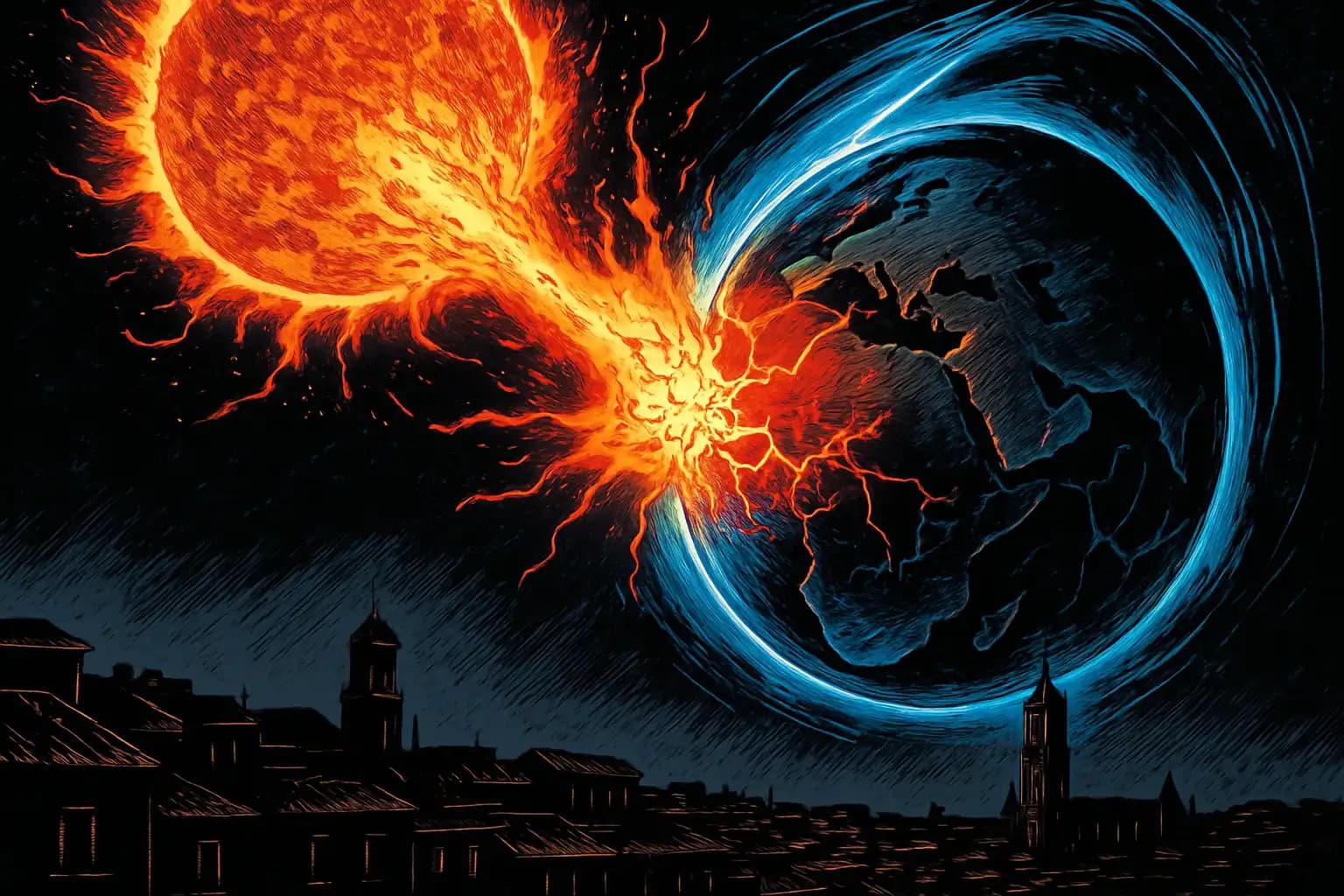Introduction: When the Lights Blink and Compasses Quiver
On a humid night, parts of Spain went dark without warning. The press release blamed a cascading grid failure, but space-weather monitors indicated a spookier story. As transformers tripped, magnetometers across Europe twitched as if an invisible hand had tugged Earth’s field. To many researchers, this coincidence was a flashing red light: our planet’s magnetic shield is warping, and the Sun is about to jab where we are weakest.
The Shield We Take for Granted
Earth’s magnetic field, generated by molten iron churning 3,000 kilometers beneath, acts like an invisible force field. It directs most charged solar particles toward the poles, where they create auroras instead of roasting living tissue. Without that barrier, high-energy radiation would strip atmospheres, fry electronics, and threaten surface life. Even a partial decline in strength can create trouble. According to scientific archives, the field has weakened roughly 10 percent since the nineteenth century. This decline matters because a weaker field allows more solar energy to seep into systems designed under stronger protection assumptions.
The South Atlantic Anomaly: A Dent in the Armor
Orbiting satellites first mapped an oddity from Brazil to Namibia. Inside this South Atlantic Anomaly, the magnetic shield thins, causing spacecraft electronics to glitch, astronauts to report extra flashes, and mission planners to schedule downtime to avoid data corruption. Recent Swarm satellite data show that the anomaly is deepening and splitting into two lobes. A quick look at regional plots from independent dashboards confirms year-over-year expansion.
Some geophysicists link the SAA to an iron “river” in the outer core that drags field lines off-center. Others suggest it may signal that the entire dipole is preparing to flip. Magnetic reversals occur every few hundred thousand years and can take centuries to complete, but transitional phases weaken the field most dramatically. Whether the anomaly foretells a full pole swap or merely a long wobble, it already incurs real costs: satellite insurers charge higher premiums, and astronauts in low-Earth orbit face extra radiation every pass through the dent.
The Spanish Blackout: Harbinger or Fluke?
One power outage does not prove a cosmic threat, yet timing is crucial. Instruments detected a moderate coronal mass ejection (CME) brushing past Earth the afternoon before Spain’s grid failure. CMEs possess their own magnetic fields; when they tangle with ours, they induce currents in long conductors—exactly the type of surge that fries transformers. Technical auditors noted abnormal reactive power spikes shortly before breakers tripped. While the official report downplayed a solar connection, utilities updated operating manuals to include space-weather alerts alongside thunderstorm advisories.
The blackout reignited online debate about geomagnetic preparedness. Comment threads referenced archived warnings at this investigative link, which argued that grids in mid-latitude nations remain more vulnerable than policymakers admit.
Solar Cycle 25: The Sun Arms for a Punch
The Sun follows an 11-year rhythm marked by sunspot counts and flare frequency. Cycle 25 looked tame at first but quickly outpaced forecasts. NOAA scientists revised expected peak numbers upward twice in eighteen months. More spots equal more eruptions; each new flare can spawn a CME. Historical analyses in economic risk studies warn that a Carrington-level storm today could cost trillions, collapsing GPS, internet backbones, and high-voltage transformers in minutes.
Pole Shift Theories and Hard Data
Movies depict instant reversals tossing oceans into skyscrapers, but real geomagnetic flips occur over millennia. Still, the lead-up can spark regional chaos. Lava flows in Oregon record temporary poles wandering at latitudes that now sit under Seattle. The geological record shows drops in field strength up to 90 percent during these flips. If a similar plunge occurred alongside today’s digital civilization, satellites would fail, birds would lose navigation cues, and high-altitude flights would face unprecedented radiation.
Recent models from geodynamics labs suggest the SAA’s growth could fit early-phase reversal patterns. Other team simulations indicate a lengthy oscillation that may stall before a complete flip. Uncertainty forces planners to consider worst-case scenarios—this mindset drives new contingency frameworks like those proposed in this technology briefing.
Collateral Damage: Infrastructure at Risk
Satellites: CubeSats and mega-constellations often lack heavy shielding. Each passage through the anomaly risks single-event upsets that can reboot or brick onboard processors. Designers now add autonomous safe-mode scripts to endure radiation spikes.
Power Grids: Long transmission lines act like antennas for geomagnetically induced currents. A detailed white paper—easily found via industry searches—shows that even moderate storms can saturate transformer cores and trigger cascading failures.
Aviation & Navigation: Airlines depend on GPS plus magnetic compasses for redundancy. Rapid pole drift forces constant recalibration of runway headings and flight management systems. Pilots on polar routes already pivot southward when space-weather warnings flash.
Biology: Many migratory species align with magnetic cues. A prolonged, uneven field may scatter whale pods and redirect bird flyways, straining ecosystems already stressed by climate change.
Preparation Playbook: Actions Above Panic
Governments can’t restore Earth’s magnetism, but they can harden vulnerable systems.
1. Grid Armor. Spark gap arresters, neutral-blocking capacitors, and strategic transformer spares cost millions—far less than rebuilding after a national blackout. Finland and South Africa already install blocking capacitors in high-risk areas.
2. Satellite Resilience. Engineers enhance error-correcting code in critical firmware and plan orbital maneuvers to avoid the SAA when possible. Operators of new mega-constellations keep spare buses ready for rapid replacement.
3. Space-Weather Early Warning. The United States, Europe, and Japan collaborate on the Space Weather Follow-On Mission, a solar observatory at L1 that gives grids approximately 45 minutes of lead time.
4. Public Education. Households can buy surge protectors, keep emergency radios, and print essential documents. Disaster agencies now bundle space-weather tips with earthquake and hurricane guides, recognizing that geomagnetic storms ignore national borders.
Signals in the Noise: What to Watch Next
The magnetic north pole races toward Siberia. The SAA continues to widen. Cycle 25 approaches its peak. Meanwhile, researchers deploy more sensors, and media outlets investigate. Long-form reports—like the deep dive available at this analysis—underscore how interconnected natural hazards are: a volcanic eruption can seed the ionosphere with ash, influencing radio propagation already disturbed by solar storms.
Financial markets adapt quietly. Metal futures spike whenever NOAA issues strong CME watches. Insurance companies rewrite satellite policies to exclude “anomaly drift” damages. Even the Pentagon prepares off-grid communication drills, echoing strategic war-game scenarios hinted at in this regional outlook.
Conclusion: Hold the Line
Spain’s blackout could be a footnote—or the first domino in a chain reaction revealing how fragile modern life is under a weakening magnetic cocoon. The physics will unfold regardless of politics, yet preparedness remains a choice. Harden what we can, monitor what we must, and respect the star that nourishes and threatens us.
Stay alert, archive data offline, and lobby utilities to invest before the Sun’s next outburst. For continuous, uncensored updates, bookmark Unexplained.co before the next geomagnetic hiccup scrambles your bookmarks.




